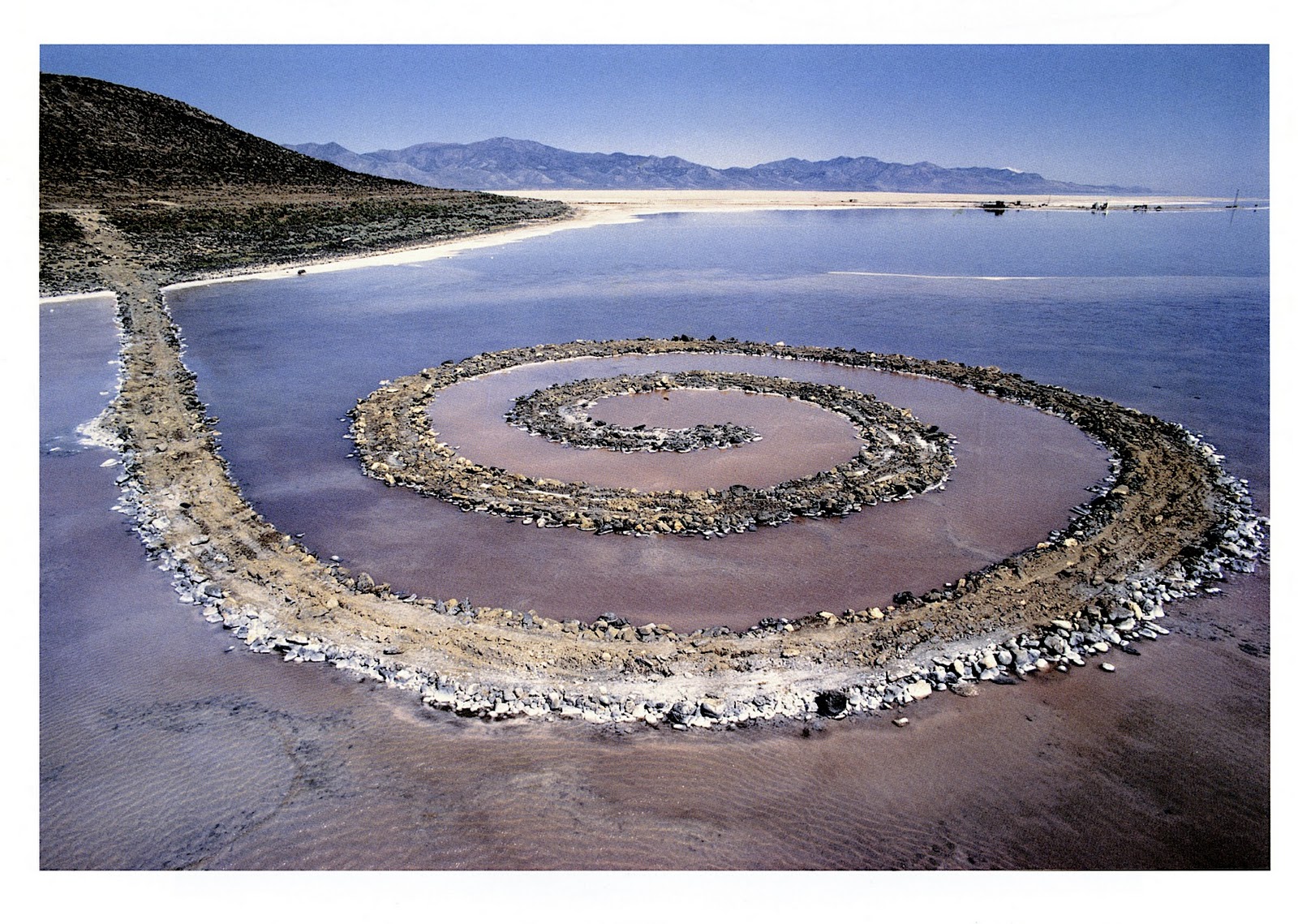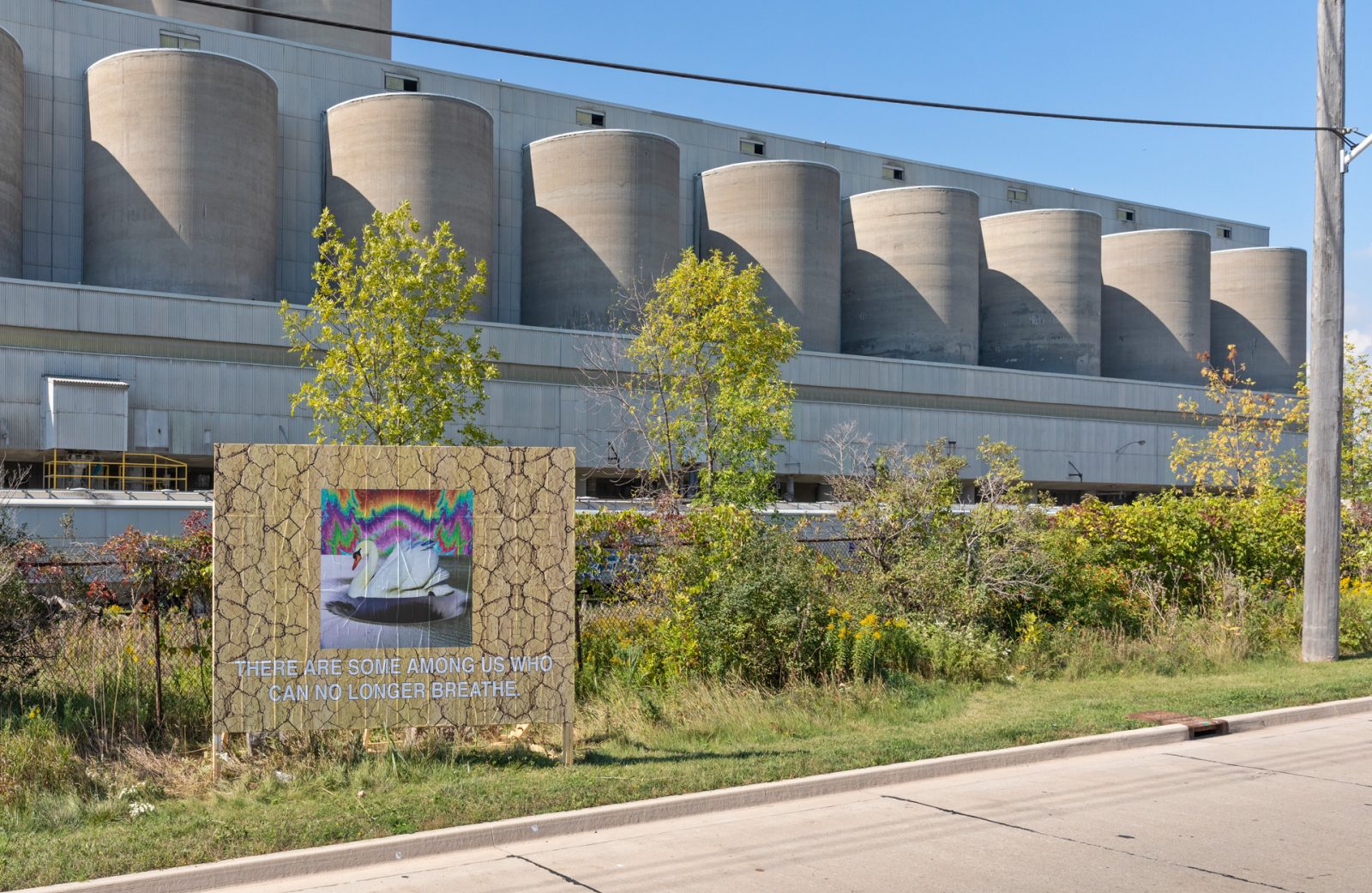
©2018 Robert Burtynsky (Art Gallery of Ontario)
A riveting photo of a still from the Anthropocene film, which also figured prominently in the AGO’s exhibition, depicting a mass-burning of elephant tusks in Kenya as a retaliatory political statement to the epidemic of elephant poaching.
What role do the arts have to play in the facilitation of a dialogue aimed at raising awareness towards the severity of the world's current environmental state?
Is such a dialogue a surefire gateway unto action-oriented change?
What value is found in the observation of mass degradation and geological maiming served up in aestheticized and digestible tidbits; ones that may be easily misread as merely means to warranting the cost of admission?
 ©1970 Robert Smithson (Good Morning Gloucester)
©1970 Robert Smithson (Good Morning Gloucester)
Land Art artist Robert Smithson’s Spiral Jetty, a 1,500-foot-long coil of mud, basalt rocks, salt crystals, and water located on the northeastern shore of the Great Salt Lake, in Utah. There are many times of the year when the sculpture cannot be seen because it is submerged in water. It took about 6 days for Smithson to construct.
Climate change has long been a topic that has found its way into more expressive circles of representation, notably seen in films such as Al Gore's An Incovenient Truth or in the ubiquitous meat-industry shaming documentary Cowspiracy . However, at this present moment, amongst the presence of an extremely powerful world leader who deems climate change "a hoax" and amidst new reports from the Intergovernmental Panel on Climate Change which surmise that completely catastrophic global devestation can only be avoided if global carbon emissions can be reduced 45% by 2030, it is so direly imperative, now more than ever, that we have all hands on deck and at the ready to commit to serious change by any possible means necessary.
The incorporation of our Mother Earth into the spheres of the more colloquial conception of "Art"- such as the visual and/or 'fine' spheres- dates back hundreds of years to the days when landscape paintings depicting the most accurate and evocative conceptions of our terrestrial domain were put on an artistic pedestal. In more recent movements of art histroy, the Land Art Movement of the 1970s and 1980s (which aligned with concurrent ascendancies of global environmental concerns) sought to expose the beauty and utilitarian application of the earth's natural resources by often showcasing natural elements as foundational materials for large scale artistic undertakings, whilst also making a statement against normative conceptions of the standards that fuelled the ever-growing capitalist tinge to art-making and its market. The work of the late American artist Robert Smithson, pictured above, aptly demonstrated the ethos and agenda of an art movement that sought to subvert the status quo through a rhetoric of environmentalist action, decades before the widespread buzz of the newly christened "Anthropocene" human epoch.
©2018 Paul Smith (CBC)
A patron takes in the large scale work of photographer Edward Burtynsky at the AGO’s Anthropocene exhibit. The picture the man is observing documents the continuing excavation of one of the biggest and oldest marble quarries in the world.
Recently, the AGO exhibited the Anthropocene exhibit, which just closed this past month after a stay at the gallery which blew expected ticket sales out of the water, conceivably alluding directly to a rising interest in concerns of an environmental nature. Also displayed at the National Gallery of Canada in Ottawa, the show is a massive undertaking by photographer Edward Burtynsky and his colleagues which is the result of years of work undertaken around the globe and also includes a film component (speaking to the scope of the appeal and success of Anthropocene, a plane which I was recently on sported the Anthropocene film as one of its few film selections on board).
Sophie Hackett, the AGO's curator of photography, hoped that the show would "spark a conversation about climate change", and surely the success of the exhibition in conjunction with the disseminative popularity of the newly christened nomenclature of the word "Anthropocene" has been doing just that. From the perspective of the department of the AGO that I have been interning in, Public Programming and Learning, the educational appeal of the show as a potential cross-sectioning of visual literacy with contemporary scientific issues was an opportunity that many schoolteachers jumped at as something to make a field trip out of. Burtynsky draws an interesting line through what it means to be an artist in 2019 by mediating it against a borderline scientific approach predicated on geology and geography. Although a worthy endeavor in my books, I overheard many of my colleagues making quips upon first seeing the Anthropocene exhibit such as that ‘it belongs more so at the ROM than at the AGO', perhaps for that it doesn't fit a traditional shape of what constitutes "Art".
(check out a link to the Anthropocene website here, featuring a trailer of the film as well as some other goodies)
 ©2018 Christina Battle (Work of Wind)
©2018 Christina Battle (Work of Wind)
One of thirteen panels from Christina Battle's multi-part work, Today in the news more black and brown bodies traumatized the soil is toxic the air is poison, sits affront an industrial backdrop to serve as an in-your-face commentary for passers by to grapple with, at last year's "The Work of Wind" exhibition in Mississauga.
The theme of environmental activism in art runs deeper than just throughout the larger institutions such as the AGO; just last year, UTM partnered with the city of Mississauga to put together a large scale art show, The Work of Wind, which had sought to raise local awareness of climate concerns by situating the exhibit transparently, in a public space in Mississauga which had long been subordinated to the consequences of processes of human extraction. The question that the show sought to ask, was one which adequately touches upon what many environmentally-cognizant arts bastions ought to be asking:
"Can artists facilitate observation of human impact on the Earth and make observation a truly public enterprise? How can observation lead to action?”
The answer surely won't be perfect, whatever that answer may end up being. Tackling climate change is a massive, massive ordeal, rife with distinct intricacies at every level. For example, I spoke with the head curator of The Work of Wind show during one of my visits, who remarked about how it is indeed tough to try to preach this idea of environmental sustainability whilst doing things like printing upwards of 10,000 70-page paper pamphlets for the show, and transporting large pieces of art by huge transport trucks, amongst other things. An article by Canadian Art from February 2017 touches on this very conundrum, asking the increasingly provocative question of, "are the creative industries the most hypocritical polluters?", citing such infractions as large museums which leave massive air conditioning or heating units running all year long for starters.
Regardless of such inevitable inconsistencies, which are largely the product of society being beholden to centuries-old processes of extraction-based sustenance, art remains one of the most viable arenas for conversation. One of the loudest, most pressing conversations of the present day and age is the one around the fragile future of our planet earth, and I personally can't think of another medium that allows for such precise encapsulation and containment of what would otherwise be transient moments than art- zeroing in on snippets of time to reflect and reconsider what stakes are entailed in those moments. Institutions like the AGO and local exhibitions such as The Work of Wind are a step in the right direction in my opinion, and although it will be extremely tricky to make the necessary global changes to save our planet, I like to believe (when my pessimism takes a momentary backseat) that not all hope is lost if everybody is given the tools to play their part.
Citations
Balzer, David. "The Carbon Footprint of Art" Canadian Art. Accessed January 24th 2019. https://canadianart.ca/features/the-carbon-footprint-of-art/
Cook, James. "Climate Change: Report Warns of Growing Impact on US Life" BBC. Accessed January 24th 2019. https://www.bbc.com/news/world-us-canada-46325168
Dunn, Trevor. "'Reconnecting us to the Wastelands': AGO's New Photo Exhibit Shows what Humanity's Doing to the Planet" CBC. Accessed January 24th 2019. https://www.cbc.ca/news/canada/toronto/ago-photography-burtynsky-1.4838375
"Robert Smithson and the 1970s Land Art Movement" Museum Network. Accessed January 24th 2019. http://museumnetwork.com/robert-smithson-and-the-1970s-land-art- movement/
